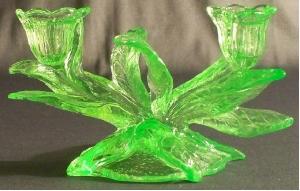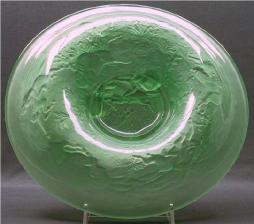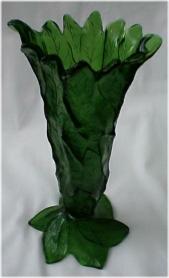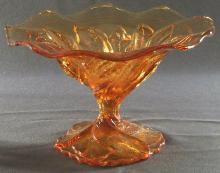National Cambridge Collectors, Inc.
A non-profit 501(c)(3) organization.

The Everglade Line
by Larry Everett
Issue No. 343 - November 2001
The Everglade Line was produced by the Cambridge Glass
Co. from 1929 - 1958 with the major production period from
 the 1930s through the mid-1940s. The items in this line
were unique. If you were unfamiliar with this line, you might
not suspect that these items were indeed produced by
Cambridge. Major motifs include many floral designs,
leaves, marsh scenes with swans, and buffalo being hunted
on horseback. Color and unique treatments also abound.
Perhaps more different colors were used during the
production of Everglade than any other line, Transparent
colors included: Crystal, Amber, Willow Blue, Eleanor Blue,
Moonlight, Blue Bell, Cobalt, Light. Emerald, Forest Green,
Topaz, Gold Krystol, and Carmen. Everglade was also
produced in several opaque colors that include: Ebony,
Crown Tuscan, Milk, and Violet. Treatments will be
discussed in more detail later, but include, Springtime,
La Fleur, and Pearl Mist. Examples are known that also
include the use of sterling silver, enameling, and gold
highlighting. There are also known examples of Everglade
items in experimental colors.
the 1930s through the mid-1940s. The items in this line
were unique. If you were unfamiliar with this line, you might
not suspect that these items were indeed produced by
Cambridge. Major motifs include many floral designs,
leaves, marsh scenes with swans, and buffalo being hunted
on horseback. Color and unique treatments also abound.
Perhaps more different colors were used during the
production of Everglade than any other line, Transparent
colors included: Crystal, Amber, Willow Blue, Eleanor Blue,
Moonlight, Blue Bell, Cobalt, Light. Emerald, Forest Green,
Topaz, Gold Krystol, and Carmen. Everglade was also
produced in several opaque colors that include: Ebony,
Crown Tuscan, Milk, and Violet. Treatments will be
discussed in more detail later, but include, Springtime,
La Fleur, and Pearl Mist. Examples are known that also
include the use of sterling silver, enameling, and gold
highlighting. There are also known examples of Everglade
items in experimental colors.
I think you are beginning to see that this is a much more
complex line than you might have first thought, and is worthy
of a more detailed study. Everglade is not for the collector
 looking for small pieces to fill a tiny space on a wall shelf.
Most of the examples are BIG, BOLD statements in glass,
designed to command attention and many were specifically
designed as table centerpieces. If you have ever had the
pleasure of seeing a large Everglade bowl with a large flower
figure (with a floral arrangement, of course) flanked by a pair
of 2 lite leaf candlesticks, you know what I'm talking about.
looking for small pieces to fill a tiny space on a wall shelf.
Most of the examples are BIG, BOLD statements in glass,
designed to command attention and many were specifically
designed as table centerpieces. If you have ever had the
pleasure of seeing a large Everglade bowl with a large flower
figure (with a floral arrangement, of course) flanked by a pair
of 2 lite leaf candlesticks, you know what I'm talking about.
Everglade items first appeared in the 1929 Spring catalog (see Smith 27-29, p. 59 & 63). These seven items were not yet part of a named line and were primarily available in Crystal, Light. Emerald, Amber, and Willow Blue. Items include; #1150 12½" bowl 3 ft.; #1151 13½" bowl, 3 ft.; #1155 4" candlestick, 3 ft; #1156** [Note: ** indicates the last known catalog appearance of an item] 4½" candlestick 3 ft. (all four of these items have a paneled floral design); #1125 15½" bowl (flip); #1126 16" bowl (turned-up edge); and #1127** 17½" bowl (flat) (all three of the last items are buffalo hunt scene).
 The 1930 January catalog (see NCC 30-34, p. 66)
marked the first time the line was named. The line was
named Springtime and the catalog listed a total of nine
items. Springtime, however, actually refers to a
treatment. All Springtime items were acid treated only on
the pattern side of the object (usually the outside) and the
non-pattern side was left untreated. New color names
were introduced and these names apply only to this line.
Therefore, if an item is acid treated on the pattern side, it
is Springtime. This allowed some items not normally
associated with the Everglade line, such as candlesticks
and flower figures to be included in the Springtime family.
The 1930 January catalog (see NCC 30-34, p. 66)
marked the first time the line was named. The line was
named Springtime and the catalog listed a total of nine
items. Springtime, however, actually refers to a
treatment. All Springtime items were acid treated only on
the pattern side of the object (usually the outside) and the
non-pattern side was left untreated. New color names
were introduced and these names apply only to this line.
Therefore, if an item is acid treated on the pattern side, it
is Springtime. This allowed some items not normally
associated with the Everglade line, such as candlesticks
and flower figures to be included in the Springtime family.
Following are the Springtime colors [Note: the Springtime color will be listed first, then the untreated (or base) color will be listed in parenthesis]: Krystol or Krystal (Crystal), Mystic (Willow Blue), Cinnamon (Amber), Rose Du Barry (Peach-blo), Jade (Light. Emerald), and Ebony (Ebony). Known examples of Springtime Gold Krystol exist; however, as of this writing, it was never listed in any known catalog or price sheet. Interestingly, advertisements of the period never used the "Springtime" name; rather the "Satin Finish" line was used. It should also be noted that Pearl Mist was introduced August 1, 1942, and these items were frosted on BOTH sides. Therefore, if an Everglade piece has been acid treated on both sides, it is Pearl Mist, not Springtime.
 Hopefully, I have not confused you this far but I must tell
you there are many more twists and turns to the
Everglade story. The next unique twist occurred in April
1930 when the La Fleur line was first advertised in the
ever popular Crystal, China & Lamps. As if a new
challenge was needed, this treatment was the same as
Springtime (acid treated on the pattern side), except the
foreground items were left clear or untreated. This was
likely accomplished by applying wax to the areas that
were to be left clear before the acid treatment. After the
glass was treated it was cleaned and the wax was
removed as part of the cleaning process.
Hopefully, I have not confused you this far but I must tell
you there are many more twists and turns to the
Everglade story. The next unique twist occurred in April
1930 when the La Fleur line was first advertised in the
ever popular Crystal, China & Lamps. As if a new
challenge was needed, this treatment was the same as
Springtime (acid treated on the pattern side), except the
foreground items were left clear or untreated. This was
likely accomplished by applying wax to the areas that
were to be left clear before the acid treatment. After the
glass was treated it was cleaned and the wax was
removed as part of the cleaning process.
If you look in Welker, Book 1, p. 69-70, you will see prices
and available treatments for several Everglade items.
The possible finishes include "C-S.F. (All Over)" and
"C—S.F. (Buffed)." Undoubtedly, the "C" stands for
Crystal; the "S.F." stands for Satin Finish, the (All Over)
 indicates Springtime or all—over satin finish on the pattern
side, and the "(Buffed)" indicates La Fleur or treatment of
the background on the pattern only side. The term
"Buffed" is not literally meaning that the item was
mechanically buffed to a shiny finish, but rather
figuratively that the highlights appear to have been buffed
or appear "shiny." It's all marketing folks! Notice also that
the prices for La Fleur items were approximately 40%
higher than the Springtime items and that the Springtime
items were approximately 40% higher than the Crystal
items. Does this same price relationship hold true today?
I will tell you that in my experience, Springtime items are
scarce and La Fleur items are more difficult to locate than
Springtime items. Colors used for La Fleur were primarily
Krystol, Jade, and Ebony, with the other Springtime colors
appearing less frequently.
indicates Springtime or all—over satin finish on the pattern
side, and the "(Buffed)" indicates La Fleur or treatment of
the background on the pattern only side. The term
"Buffed" is not literally meaning that the item was
mechanically buffed to a shiny finish, but rather
figuratively that the highlights appear to have been buffed
or appear "shiny." It's all marketing folks! Notice also that
the prices for La Fleur items were approximately 40%
higher than the Springtime items and that the Springtime
items were approximately 40% higher than the Crystal
items. Does this same price relationship hold true today?
I will tell you that in my experience, Springtime items are
scarce and La Fleur items are more difficult to locate than
Springtime items. Colors used for La Fleur were primarily
Krystol, Jade, and Ebony, with the other Springtime colors
appearing less frequently.
In the 1930 January catalog (see NCC 30-34, p. 67-69) there are also 10 different table center sets shown. These center bowls could be purchased complete with either a Bashful Charlotte or a Draped Lady figure flower holder and a pair of one-, two- or three—lite candelabra. All of these items were available with the Springtime treatment. An interesting feature on the "paneled floral," "swan," and "buffalo hunt scene" bowls with three feet was that the feet were designed from natural elements. The feet on the "paneled floral" bowls are shaped like turtle heads, the feet on the "swan" bowls are lily pad shaped, and the feet on the buffalo hunt scene bowls are shaped like boulders. For the adventurous, you are invited to look under the buffalo's tail where you will find the designer`s initials. From a 1972 interview with Mary Martha Mitchell, it was learned that the buffalo hunt scene design was copied from a Frederic Remington painting and took over nine months to complete. She also stated that this design did not sell well and was discontinued shortly after its introduction.
The first time the "leaf"' line appeared was in the "Miscellaneous" listing of the early 1931 catalog (see NCC 30-34, p. 104). The one-lite #1209 candlestick could also be used as either a #1210 vase ("lily" peg vase) or as a #1211 12" vase ("straight" top peg vase). Both these peg vases are very difficult to acquire, especially in color. The #1211 2-lite candelabra also appeared for the first time. Both these candlesticks were renumbered more than five times during their production over the years.
Three items also appeared in the "Business Stimulators"
listing of the early 1930 catalog (see NCC 30-34, p. 113).
All of the items appearing here appeared in the catalog
for the last time, they include: #1252** 10" vase (daffodil),
#1256** oval bowl (tulip) and the #1253** 12" vase (tulip).
 [Note: the two tulip molds were reworked and appeared
again in the 1940 catalog. The scalloped edges were
added to the oval bowl and the vase was reduced in size
to 10½", also the background was changed.]
The only item that appeared in the 1932 catalog was the
#1319 4½" vase (see NCC 30-34, p. 141).
[Note: the two tulip molds were reworked and appeared
again in the 1940 catalog. The scalloped edges were
added to the oval bowl and the vase was reduced in size
to 10½", also the background was changed.]
The only item that appeared in the 1932 catalog was the
#1319 4½" vase (see NCC 30-34, p. 141).
This vase has an interesting story of its own. It can also be found with an incised mark "France" on the bottom. The story goes that a gentleman in France sent this mold along with some other molds (lady leg bookends for one) to Cambridge to have some glass produced. The theory goes that Cambridge either purchased the molds after the order was completed or entered into an agreement to also allow Cambridge to market some of the production pieces. This was not at all uncommon for the period, as even Cambridge may have sent pieces to Millersburg to receive the "Carnival" (iridized) treatment. It is felt however, that a vase marked "France" is not a Cambridge production piece.
Finally, in the 1933 catalog, pieces appeared for the first
time listed in the "Everglade" section (see NCC 30-34,
p. 187, 190-196). More than 50 items were listed,
including for the first time table service items. These
included an 8" plate, 7½" bowl (salad), sherbet, cream
and sugar. The one-lite leaf candlesticks also appeared
for the first time as a #32** leaf "up" or the #33 leaf
"down" variation. The "lily" vase insert gets quite a
workout as not only for the candlestick and candelabrum,
but also is used in the #53 2 pc. epergne and the #51 2
pc. epergne. The #38 11" leaf vase also is modified into a
 peg vase and is used in the #37** 13" 2 pc. oval epergne
and the #55** 14½" oval 2 pc. epergne. The rather
unusual (and rare) ruffled vase inserts appear for the first
and only time in a catalog as the #45** 2 pc. flower holder
and the #58** 3 pc. flower holder.
peg vase and is used in the #37** 13" 2 pc. oval epergne
and the #55** 14½" oval 2 pc. epergne. The rather
unusual (and rare) ruffled vase inserts appear for the first
and only time in a catalog as the #45** 2 pc. flower holder
and the #58** 3 pc. flower holder.
The vases were reworked during this period to a more rounded appearance at the top. Many of the earlier vases appeared with six distinct sides at the top. The tulip vase was also shortened to 10½" and the stippled background was removed. These changes were most likely made to speed production, reduce breakage, and most importantly, to reduce costs.
In the early 1934 catalog one item was added to the Everglade line. The #42 6" leaf comport was added to the 16" tulip plate to create the #60 16" cheese and cracker. Also in 1934, the Willow Blue name was changed to Eleanor Blue. This change was in name only as the glass formula and color were not changed. This change was most likely to honor the first lady, Eleanor Roosevelt. Crown Tuscan was also introduced to the line during this time period.
The January 1, 1940 catalog listed a total of 23 items in
the Everglade line. Ten items were removed from the
 1934 listing. One item was renumbered (the #1 leaf bowl
became the #61 10" leaf bowl). One item was added (the
#62 3½" single lite candle). This candle appeared much
like the #33 single lite leaf candle with the upper leaves
cut off. Two items were reworked; the #10 single lite
candle was reduced in height from 4" to 3½" and the
#36 tulip oval bowl had a ruffled top edge added.
1934 listing. One item was renumbered (the #1 leaf bowl
became the #61 10" leaf bowl). One item was added (the
#62 3½" single lite candle). This candle appeared much
like the #33 single lite leaf candle with the upper leaves
cut off. Two items were reworked; the #10 single lite
candle was reduced in height from 4" to 3½" and the
#36 tulip oval bowl had a ruffled top edge added.
Also in January 1940, the Arcadia line was introduced. There were a total of 53 items in this line. The line featured a smaller leaf motif and included some of the leaf table service items that were introduced in 1933. This line was less labor intensive to produce. The production period is unknown, but likely limited to a few years.
In January or February 1954, Milk was introduced. Milk was produced until the factory closed in July 1954. Six items were listed in the "Milk" supplement, but the production figures are unknown (see NCC 49-53 p. 289). The items listed are; W115 16" tulip plate, W116 12" oval tulip bowl, W126 5" ivy vase, W127 6" trillium vase, W128 7½" daffodil vase, and the W129 12" tulip vase. Crown Tuscan items were produced from 1942 until the factory closing, but items produced in this color are also seldom found.
During the reopen period (March 1955 - 1958) Violet was introduced to the Everglade line (see Colors p. 102). items produced in this color are also seldom found. The most often found experimental color of Everglade is a pink color with an opalescent edge (see Colors p. 104). However, note that finding any example in an experimental color is much more difficult than finding the proverbial "needle in the haystack."
Some of the Everglade items have been reproduced.
Summit Art Glass produces some pieces yet today. It is
important for the reader to understand that while old
molds can still be used today to produce glass, this glass
cannot be produced in the original shapes if skilled
handwork was required to further shape the glass. This is
for two main reasons:
1) the lack of skilled labor, and
2) the economic incentive to do so.
To look at this further, most large pieces came out of the mold in a shape very similar to the #15 "swan" bowl shown in NCC 30-34, p.193. After the piece was removed from the mold, it could be further worked into the #16 bowl (fluted edge), the #17 bowl (rolled edge), or the #18 bowl (rolled-up edge platter), which are shown on the same page. If you will turn to page 67, also in the 30-34 catalog, you will see two additional shapes that were made. These are the #1140** bowl (turned up edge) and the #1139** bowl (flip). The last two shapes must have been particularly difficult or expensive to produce, as they appeared only in the January 1930 catalog. The other Everglade bowls (tulip and buffalo hunt scene) were also found in these same shapes. The reason that only one mold was used to produce all these shapes was one of simple economics. Molds were very expensive. To create individual molds for some of these large bowls would be cost prohibitive. Additionally, the molds would have been so large that they would have been very difficult to work with. So, bottom line, if you discover a piece of Everglade in a shape not produced by Cambridge, it most likely is of recent production and in a shape very nearly like the shape of the item as it was taken directly from the mold.
Imperial produced some Everglade items after the Cambridge factory closed, but generally did not use colors similar to Cambridge colors.
Summit Art Glass is known to have produced the #24 sherbet, the #105 mayonnaise with ladle, and the buffalo hunt scent bowl. Summit also has in their possession at least two additional Everglade molds. They are the large tulip bowl and the large swan bowl. However, it is unknown if items can or will be produced from these molds.
I hope you have enjoyed this discussion of the Everglade line. This line is a rather difficult one to grasp without some in-depth study. As you have learned, the line has used several names (Springtime, La Fleur, Leaf, Arcadia, and Everglade) during its long production period (1929 - 1958). The line contains many unique and scarce items. Several items were designed specifically for decorating with flower centerpieces and the color choices of the glass are extremely broad. Perhaps this is a line that might interest you?
[Authors Note: Much of the material contained in this article came from a presentation on the Everglade line at the 2001 NCC Convention and was presented by the Miami Valley Study Group. We are giving the updated master of the handout material, that was distributed at the presentation, to the NCC. It is our hope that this material will be available for sale soon.]